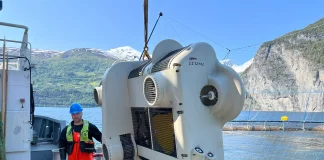“We did tests where we compared what kind of effect it had if the machines were dressed up like fish or turtles, as opposed to regular underwater vessels.” Bioinspired “CageReporter” can get up close to fish in SalMar’s salmon cages in pioneering study.
New research shows that fish are more aware of their surroundings and technologies in cages than previously assumed. Now research is now being done on how stealthy “turtle” robots can increase fish welfare.
Gemini.no – which publishes research news from NTNU (Norwegian University of Science and Technology) and SINTEF(one of Europe’s largest independent research organisations) – is reporting on a new field of research that looks at the interaction between fish and robots.
The results so far indicate that fish are much more affected by the environment than scientists previously thought. Therefore the bioinspired robots have been designed so that the fish are not disturbed by them.
SINTEF participates in several different research projects that investigate solutions for autonomous, or self-propelled underwater robots in fish cages. This includes a small robot, which has been named “CageReporter”. It will observe life in the cages 24/7, as well as alternative designs of the robots.
The experiments have been done in SINTEF ACE, which is a full-scale aquaculture laboratory, run by SalMar.
“Our research and our technology solutions will make the fish better. It is good news for both industry and the environment. The salmon farmers are, of course, very positive,” said SINTEF researcher Eleni Kelasidi.

Can’t adopt technology directly from oil and gas
In other industries, such as oil and gas, underwater robots have been used for a while. But scientists are now developing more flexible solutions that can move on their own and with artificial intelligence so that they can cope with active environments and interact with fish and fauna in a better way.
“Through this research, we hope to challenge the supplier industry to design and develop underwater vehicles that are adapted to operations in fish farms, which can be operated in the presence of fish. We cannot adopt solutions developed for oil and gas for aquaculture since the variable environment one is exposed to in a fish farm is very different from the conditions one typically experiences in offshore operations,” said Kelasidi.
The “CageReporter” concept The SINTEF researchers, together with industrial partners, are such an autonomous machine that must be able to report from cage to operator 24 hours a day.
“The “CageReporter” is a subsea vessel that will carry out high-quality data capture. It will continually look for holes in nets that can lead to fish escapes, as well as monitor everything from temperatures to the fish’s condition,” said Kelasidi.
In this way, the robot should be able to detect potentially harmful changes and hazards immediately, so that the farmer can prevent escapes or other injuries.

Health and safety benefits
Today, the industry mainly operates with cages, each containing up to 200,000 salmon and none of these are currently under surveillance 24/7. With this technology, one can keep up with all the time without the need of having people there all the time. This means, among other things, that it’s not necessary to send crews to facilities in difficult weather conditions, and that one can quickly find holes so that one can prevent escape, which is important for protecting the environment.
“In addition, “CageReporter” will help you get an overview of how often you have to clean, feed or initiate other measures. What we give the opportunity to be at the forefront of the situation, to avoid financial losses and take care of the environment,” said Kelasidi.
So far, the research team and the collaboration companies have made a number of tests on individual properties: For example, camera positions on the robot, various camera systems, control and navigation systems.
In the new year, the plan is to test all components at full scale, at the same time at SINTEF ACE, the full-scale laboratory facility designed to develop and test new aquaculture technologies.
Underwater vessels mimic turtles
SINTEF Ocean has also assisted researchers from the University of Tallinn, Estonia, in conducting experiments on the machines’ appearance at the project AQUAEXCEL2020 (a Horizon 2020 research infrastructure project which aims to support the sustainable growth of the aquaculture sector in Europe). So far, these experiments have been focused on studying how machines that look like and move like turtles and fish affect fish in cages.
“Today, divers or underwater vessels are operated by operators to perform work in cages. We did tests where we compared what kind of effect it had if the machines were dressed up like fish or turtles, as opposed to regular underwater vessels. We saw, among other things, whether that would make the fish less stressed, what manoeuvres disturbed them the least and how fish move according to different sounds. The results of the first tests were very promising,” said Kelasidi.
The biologists at the University of Tallin are currently investigating the data more thoroughly.
“The results of this research can be used as a basis for developing solutions that will improve the bio-interactive technology in the fish cages. The fish in our experiments behave quite differently to systems that both see and move in different ways, so now our task is to give the industry the information we get from the experiments so that they can make the vessels in a way that affects the fish less, while at the same time one needs to perform necessary operations,” said Kelasidi.
Read more on the project’s website via this link.










